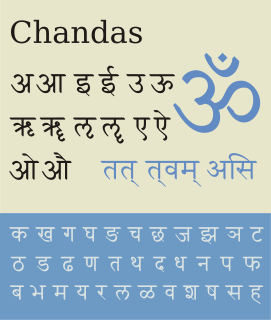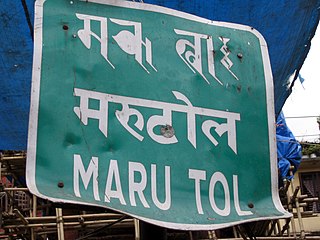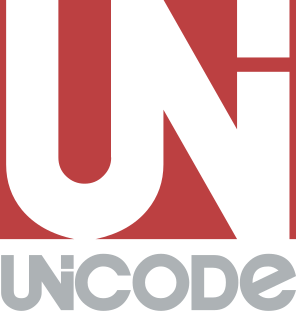
Devanagari, also called Nagari, is a left-to-right abugida (alphasyllabary), based on the ancient Brāhmī script, used in the Indian subcontinent. It was developed in ancient India from the 1st to the 4th century CE, and was in regular use by the 7th century CE. The Devanagari script, composed of 47 primary characters including 14 vowels and 33 consonants, is one of the most adopted writing systems in the world, being used for over 120 languages. The ancient Nagari script for Sanskrit had two additional consonantal characters.

The Tibetan alphabet is an abugida used to write the Tibetic languages such as Tibetan, as well as Dzongkha, Sikkimese, Ladakhi, and sometimes Balti. The printed form of the alphabet is called uchen script while the hand-written cursive form used in everyday writing is called umê script.

The Soyombo alphabet is an abugida developed by the monk and scholar Zanabazar in 1686 to write Mongolian. It can also be used to write Tibetan and Sanskrit.

The Kharosthi script, also spelled Kharoshthi or Kharoṣṭhī, was an ancient Indian script used in Gandhara to write Gandhari Prakrit and Sanskrit. It was popular in Central Asia as well. An abugida, it was introduced at least by the middle of the 3rd century BCE, possibly during the 4th century BCE, and remained in use until it died out in its homeland around the 3rd century CE. It was also in use in Bactria, the Kushan Empire, Sogdia and along the Silk Road, where there is some evidence it may have survived until the 7th century in the remote way stations of Khotan and Niya. Kharosthi is encoded in the Unicode range U+10A00–U+10A5F, from version 4.1.
The Sogdian alphabet was originally used for the Sogdian language, a language in the Iranian family used by the people of Sogdia. The alphabet is derived from Syriac, a descendant script of the Aramaic alphabet. The Sogdian alphabet is one of three scripts used to write the Sogdian language, the others being the Manichaean alphabet and the Syriac alphabet. It was used throughout Central Asia, from the edge of Iran in the west, to China in the east, from approximately 100–1200 A.D.

The Rañjanā script (Lantsa) is an abugida writing system which developed in the 11th century in Nepal. It is the original script of the Newar language and is used till this day. Nowadays it is also used in Buddhist monasteries in India, China, especially in the Tibetan Buddhist areas within the Tibet Autonomous Region, Sichuan, Yunnan, Qinghai and Gansu, Mongolia, and Japan. It is normally written from left to right but the Kutakshar form is written from top to bottom. It is also considered to be the standard Nepali calligraphic script.

Tigalari or Tulu (Tigaḷāri lipi, Tuḷu lipi) is a southern Brahmic script used in the Coastal region of Karnataka, also prevalent in Kasaragod district of Kerala. It evolved from the Grantha script. It bears high similarity and relationship to its sister script Malayalam, which also evolved from the Grantha. It was mainly used by Tulu-speaking Brahmins like Shivalli Brahmins and Kannada speaking Havyaka Brahmins and Kota Brahmins to write Vedic mantras and other Sanskrit religious texts. Sanskrit is the main language of the script. But some Kannada and Tulu works are also available. It is currently not used to write the Kannada and Tulu languages as they use the Kannada script for documentation. However, there has been a renewed interest among Tulu speakers to revive the script as it was formerly used in the Tulu speaking region. The Karnataka Tulu Sahitya Academy, a cultural wing of the Government of Karnataka, has introduced Tuḷu language and Tigalari-Tulu script in schools across the Mangalore and Udupi districts. The Academy provides instructional manuals to learn this script and conducts workshops to teach it. Tigalari-Tulu was proposed for inclusion in Unicode in 2011. as well as in 2017
Zhang-Zhung is an extinct Sino-Tibetan language that was spoken in what is now western Tibet. It is attested in a bilingual text called A Cavern of Treasures and several shorter texts.

The expression Nepalese Scripts refers to alphabetic writing systems employed historically in Nepala Mandala by the indigenous Newars for primarily writing Nepalbhasa and for transcribing Sanskrit. There are also some claims they have also been used to write the Parbatiya (Khas) language but all Pahari languages were traditionally written with the Takri alphabet and now Devanagari.

Palm-leaf manuscripts are manuscripts made out of dried palm leaves. Palm leaves were used as writing materials in the Indian subcontinent and in Southeast Asia dating back to the 5th century BCE, and possibly much earlier. Their use began in South Asia, and spread elsewhere, as texts on dried and smoke treated palm leaves of Borassus species or the Ola leaf.

The Tocharian alphabet is a version of Brahmi script used to write the Central Asian Indo-European Tocharian languages, mostly from the 8th century that were written on palm leaves, wooden tablets and Chinese paper, preserved by the extremely dry climate of the Tarim Basin. Samples of the language have been discovered at sites in Kucha and Karasahr, including many mural inscriptions.

The Śāradā, Sarada or Sharada script is an abugida writing system of the Brahmic family of scripts. The script was in widespread use between the 8th and 12th centuries in the northwestern parts of India, for writing Sanskrit and Kashmiri. The Gurmukhī script was developed from Śāradā. Originally more widespread, its use became later restricted to Kashmir, and it is now rarely used except by the Kashmiri Pandit community for ceremonial purposes.
Siddhaṃ, also known in its later evolved form as Siddhamātṛkā, is a script used for writing Sanskrit from c. 550 – c. 1200. It is descended from the Brahmi script via the Gupta script and later evolved into the Bengali alphabet, Maithili alphabet, and the Tibetan alphabet. There is some confusion over the spelling: Siddhāṃ and Siddhaṃ are both common, though Siddhaṃ is preferred as "correct". The script is a refinement of the script used during the Gupta Empire.
For the work of the same title by Shantarakshita, see Tattvasamgraha
Pecha is a Tibetan word meaning "book", but in particular, refers to the traditional Tibetan loose-leaf books such as the kangyur, tengyur, and sadhanas. Pechas sometimes have top and bottom cover plates made of wood, cardboard, or other firm materials, and are often seen wrapped in cloth for protection. The word pecha has entered common use in other languages such as English in the Tibetan Buddhist community, evident online in discussion forums and software products that include the word in their names.
Nandinagari is a Brahmic script derived from Nāgarī script which appeared in the 7th century AD. This script and its variants were used in the central Deccan region and south India, and an abundance of Sanskrit manuscripts in Nandinagari have been discovered but remain untransliterated. Some of the discovered manuscripts of Madhvacharya of the Dvaita Vedanta school of Hinduism are in Nandinagari script.
The Gunjala Gondi lipi or Gunjala Gondi script is a script used to write the Gondi language, a Dravidian language spoken by the Gond people of northern Telangana, eastern Maharashtra, southeastern Madhya Pradesh, and Chhattisgarh. Approximately a dozen manuscripts in the script were recovered from Gunjala, a Gond village in Adilabad district of Telangana by a team of researchers from the University of Hyderabad, led by Professor Jayadheer Tirumala Rao. The script and preliminary font were unveiled in early 2014.
Bhaiksuki is a Unicode block containing characters from the Bhaiksuki alphabet, which is a Brahmi-based script that was used for writing Sanskrit during the 11th and 12th centuries CE, mainly in the present-day states of Bihar and West Bengal in India, and in parts of Bangladesh.















